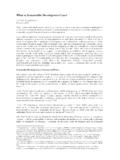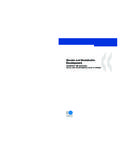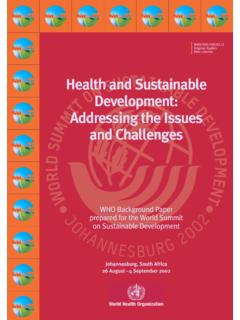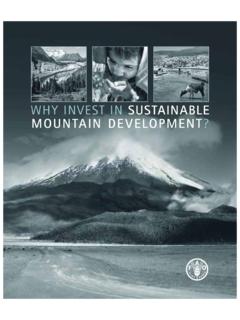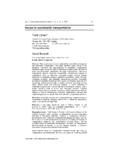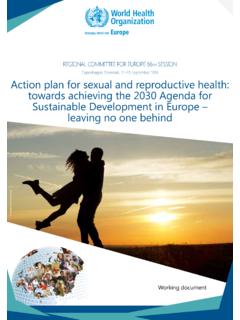Transcription of FAO working for SDG 14
1 fao working for sdg 14 Healthy oceans for food security, nutrition and resilient communitiesCONTENTSPAGES 4 5 INTRODUCTION PAGES 6 7 SAFEGUARDING OUR OCEANS PAGES 8 9 KEY MESSAGES PAGES 10 11 THE SPECIAL ROLE OF FISH IN HUMAN NUTRITIONPAGES 12 13 FAO S ROLE AS CUSTODIAN FOR SDG 14 INDICATORS PAGES 14 23 HOW FAO CONTRIBUTES TO ACHIEVING SDG 14 PAGE 24 35 FAO HELPING COUNTRIES ACHIEVE SDG 14 Cover photo: C TE D'IVOIRE - Child eating fish at Abobodoume Fish Market. FAO/S. KambouVIET NAMA bustling fish market in Viet Nam. FAO/T. Minh DienFAO working FOR SDG 14"EFFECTIVE AND sustainable MANAGEMENT OF MARINE RESOURCES IS ESSENTIAL TO ACHIEVING SDG 14, AND IN CONTRIBUTING TO FOOD SECURITY AND NUTRITION FOR ALL".FAO Director-General Jos Graziano da Silva4 INTRODUCTIONI ntegrating the three dimensions of sustainable development economic growth, social inclusion and environmental protection the SDGs are universal, interconnected and indivisible.
2 As relevant to developed as they are to developing nations, they call for comprehensive and participatory approaches, bringing together everybody to leave no one behind. The SDGs succeed the Millennium development Goals, and are now the main global reference for development policies. With its importance to food security, climate regulation, whole communities and the very future of individual states, achieving SDG 14, Conserve and sustainably use the oceans, seas and marine resources for sustainable development , is a major priority of the 2030 25 September 2015, the 193 Member States of the United Nations adopted the 2030 Agenda for sustainable development , including 17 sustainable development Goals (SDGs) with 169 targets and 230 indicators. Defined and fully owned by countries, the 2030 Agenda is a global vision for people, for the planet and for long-term prosperity.
3 It charts a plan for the future, shifting the world onto a sustainable and resilient course in leading to a transformation in living 2030 Agenda aims to tackle the complex challenges facing the planet today ending poverty, hunger and malnutrition, and responding to climate change while achieving inclusive growth and sustainably managing natural resources. SDG 14 IS A MAJOR PRIORITY OF THE 2030 AGENDA. Our planet faces multiple and complex challenges in the twenty-first 2030 Agenda for sustainable development commits the international community to act together to surmount them and transform our world for present and future working FOR SDG 145 CUBAW omen wait for fishing boats to return with the catch of the day. FAO/V. Crespi6 HEALTHY OCEANS AND SEAS ARE MORE IMPORTANT THAN OUR OCEANSO ceans and seas support livelihoods and whole communities, providing nutritious food and potential for prosperity for hundreds of millions of people around the world.
4 Covering more than 70 percent of the surface of our planet, oceans and seas provide half of the world s oxygen, sequester carbon, and serve as home to 80 percent of life on stand-alone goal in the form of SDG 14, which aims to conserve and sustainably use the oceans, seas and marine resources for sustainable development , clearly illustrates their crucial role for human well-being and the health of our recognition of the importance of conserving our ocean resources is helping build global momentum around this issue. However, SDG 14 goes far beyond conservation to focus on the people and coastal communities, particularly those in developing countries, who rely on these marine resources. Oceans, along with coastal and marine resources, play an essential role in human well-being and social and economic development worldwide.
5 They are particularly crucial for coastal communities, who represented 37 percent of the global population in 2010. Oceans provide livelihoods and tourism benefits, as well as subsistence and income. Fisheries sustain millions of jobs and often pass down traditions and knowledge from generation to generation. Fish is among the most widely traded food commodities, at a value of USD 145 billion annually. Sixty percent of the volume of fish trade originates in developing countries, providing opportunities to workers in the fisheries and aquaculture sectors. And fish has the potential to help meet the demand for nutritious food of the nearly 10 billion projected to live on earth in 2050. Healthy oceans and seas are more important than beyond ocean conservation, SDG 14 focuses on people and coastal communities who rely on marine working FOR SDG 147 INDONESIAA local fisherman displaying the day's catch.
6 FAO/J. HolmesFAO AND SDG 14 fFAO is custodian agency for four ( , , and ) of the 10 SDG 14 indicators, from a total of 21 indicators across the SDGs for which the Organization has been given a custodianship role. FAO provides countries with information on optimum levels of fishing, aquaculture expansion and fair and secure access to living aquatic resources and markets. fFAO is responsible for binding and non-binding instruments negotiated with member countries that can help achieve SDG 14, including the FAO Code of Conduct for Responsible Fisheries, the FAO Port State Measures Agreement, the Voluntary Guidelines on Catch Documentation Schemes, the Voluntary Guidelines for Securing sustainable Small-Scale Fisheries, and ecolabelling sea of opportunity to end poverty, achieve zero hunger and feed the futureFisheries already provide more than billion people with 20 percent of their daily animal protein intake, but oceans and seas offer vast potential to feed the near 10 billion people who will live on Earth in 2050.
7 About 70 percent of the planet provides less than 5 percent of our food. By investing in fishing communities, curbing overfishing and sustainably managing the oceans, we are contributing to multiple targets from SDG 14 right across the 2030 leave no one behind, we must promote fishing communitiesFisheries and aquaculture support the livelihoods of 10 12 percent of the world s population. The best way to sustain employment within the world s fishing villages, to reduce the need for urban migration and preserve sea vitality while countering the threat from overfishing and ocean pollution is to share the riches of the seas more evenly and give coastal communities greater access to resources and involvement in the oceans sustainablyMoving beyond conservation to sustainably using our oceans and other natural resources will define SDG 14 s success.
8 Blue Growth is designed to deliver development in three dimensions, balancing a focus on growth and conservation, industrial and small-scale fisheries and aquaculture, while fostering cooperation among countries and partnerships among actors. Promoting Blue Growth can accelerate progress across the SDGs, and maximize benefits for Small Island Developing MESSAGES FAO NOURISHING PEOPLE, NURTURING THE PLANETA specialized UN agency working in the three dimensions of sustainable development , FAO is assisting countries to implement the 2030 Agenda by offering technical and monitoring expertise, and support to policy design, participatory governance, partnership building and resource mobilization efforts. FAO S WORK REACHES RIGHT ACROSS THE SDGs Addressing the linkages of SDG14 with other 2030 Agenda targets, particularly under SDG 1, no poverty, SDG 2, zero hunger, and SDG 8, decent work and economic growth, FAO acts hand-in-hand with governments, small producers, fishing communities, labour unions, civil society organizations, scientists and other key actors in food security and sustainable development in projects and programmes across the working FOR SDG 149 PHILIPPINESW omen play an important role in fisheries and aquaculture.
9 FAO/P. Suuronen10 THE SPECIAL ROLE OF FISH IN HUMAN NUTRITIONAs recognized at the Second International Conference on Nutrition in 2014, fish has an important role to play in human nutrition. More than billion people around the world depend on fish for at least 20 percent of their total animal protein intake. Population growth and economic development will increase demand for fish as part of a healthy is not only a source of proteins and healthy fats, but also a unique source of essential nutrients, including long-chain omega-3 fatty acids, iodine, vitamin D, and calcium. The multiple benefits of fatty fish high in omega-3s and small fish eaten whole, which contain nutrients in the skin and bones, clearly illustrate seafood s irreplaceable nutritional increased focus on fish and nutrition aids both developing countries and the developed world.
10 In many developing countries, fish is the main or only source of animal protein, and is essential to providing micronutrients. Dietary patterns are also shifting in developed and middle-income countries, and an increasing emphasis on non-communicable diseases and overall health has led to an increased demand for , fish plays a crucial role in a child s healthy development . Expectant women throughout the world face demanding nutritional needs. The so-called 1 000 day window of a child s life from pregnancy to the child s second birthday is now recognized as a key time Seas and oceans have the potential to help meet the demand for nutritious food of the almost 10 billion projected to live on Earth in 2050. to promote proper nutrition for development . Fish consumption by expectant mothers aids their children s neurodevelopment, from promoting optimal brain development to ensuring strong bone growth and providing sufficient levels of iron and fisheries management practices that safeguard our fisheries resources for future generations are more crucial than IS NOT ONLY A SOURCE OF PROTEINS AND HEALTHY FATS, BUT ALSO A UNIQUE SOURCE OF ESSENTIAL working FOR SDG 1411 Nature s superfoodKEY FACTS & FIGURES More than billion people depend on fish for at least 20% of their total animal protein intake, and a further billion people for 15% of animal protein undervalued and discarded parts of the fish, like the head, viscera and back-bone.











